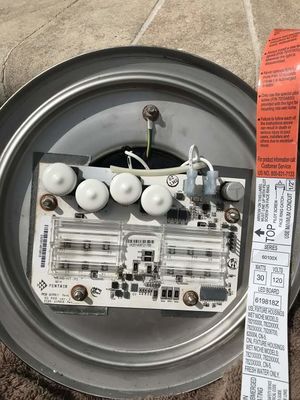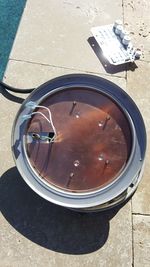m (ajw22 moved page Pentair Globrite Light to Pentair LED Pool Lights: Expanded wiki page to cover all LRD light models) |
m (Removed Stub) |
||
| Line 1: | Line 1: | ||
| − | |||
| − | |||
=Pentair LED Pool Lights= | =Pentair LED Pool Lights= | ||
Revision as of 23:17, 15 April 2020
Pentair LED Pool Lights
Pentair has three models of LED lights. They vary in size and type of niche required.
Pentair MicroBrite
The MicroBrite is Pentair's latest 3rd generation LED light. MicroBrite lights are a compact 12V LED light that is only 3.5 inches long and installs in any standard 1.5 inch pool wall fitting. No light niche is required.
The MicroBrite lights connect to any Pentair automation control system or the IntelliBrite controller.
The MicroBrite lights come in two versions.
- The 12 VAC MicroBrite White Light has three different brightness levels. There is a white light model and a warm white light model of the MicroBrite White Light.
- The MicorBrite Color light has seven pre-programmed color light shows or one of five selectable fixed colors. The MicroBrite Color light can be cycled through 14 settings - 7 party mode setting and 5 fixed colors - blue, green, red, white, magenta.
The MicroBrite lights are non-serviceable. The complete light assembly must be replaced if anything fails in them. The MicroBrite light cannot be used on a dimmer circuit. Using the MicroBrite on a dimmer switch will result in permanent damage to the light.
Pentair IntelliBrite 5G
The IntelliBrite 5G was Pentair's first generation LED pool light. The Intelligrite comes in both a white light model and a color changing model. You can choose from 5 predetermined fixed colors (blue, green, magenta, white and red) or 7 popular preprogrammed "color shows".
The beam pattern of the white light can be adjusted by rotating the lens 180 degrees for a wide or narrow beam pattern. The IntelliBrite 5G comes in 120V and 12V versions.
Intellibrite 5G lights can be controlled by a:
- IntelliTouch, EasyTouch or IntelliCenter automation system
- IntelliBrite Control panel
- standard wall-mount light switch.
Multiple IntelliBrite lights can be connected via a junction box to a single control so that all lights can be switched on and off together. If you want to control lights individually for on/off and color changes they need to be on separate circuits and individual relays in an automation controller.
The IntelliBrite 5G light cannot be used on a dimmer circuit. Using the IntelliBrite on a dimmer switch will result in permanent damage to the light. This screw mounts and electrically grounds the housing securely to the mounting ring and wet niche. Failure to use the screw provided could create an electrical hazard which could result in death or serious injury to pool users, installers or others due to electrical shock.
Note that the pilot screw holding the face ring to the housing is bronze or stainless steel and must be used.
Early Model IntelliBrite Defect
Pentair had problems with early gen IntelliBrites and had since fixed the problem. Apparently they had some defective chips on the board, and the board itself was backed by a thin aluminum heat sink that was found to be inadequate. They now have a thick copper heat sink and he claimed they haven't had to replace any of those yet.[1]
They always lose the red color first. It's the driver in the light that goes bad and a replacement driver is nearly $400. Might as well just but a new light
The U1 chip that seems to blow up is a Linear Technologies (now Analog devices) LT3496 LED driver, packaged in an impossibly-small-to-hand-solder UFD form factor. They make a 125 and a 150 degree C version but they have the same markings so we can't tell what's actually on the board.[2]
A member examined two of these boards on his bench:
- The first has the older smaller aluminum heat sink backing and weighs 3.6 oz. This one has a visibly smoked U1
- The second has the extra copper heat sink backing and weighs 6.5 oz. This board probably works but J4 has been torn off, taking the board traces with it. This is a different issue but the board was designed with a surface mount quick-fit connector whereas I'd prefer to see a stronger physical connection to the board. Considering their cost, these things should be able to deal with a bit of force!!
Digi-Key has the 150 degree U1/LT3496H part[3] (H denotes the 150 degree version) for 9 bucks and change.
The datasheet suggests that if the junction temperature gets over 125/150 degrees it will have problems. If these failures are indeed heat related, He is not yet sure which part is actually overheating. it could be the driver itself, or it could be that another part - in conjunction with the thin heat sink - gets hot enough to raise the temperature of the entire board above the driver's junction temp threshold and smokes it. 125/150 degrees C is pretty hot though.
IntelliBrite Heatsink Hack
Overheating seems to damage the InetlliBrite driver boards. Some failed boards show charred brown spots.[4]
Looking closer at the design of this light, the heat is intended to transfer from the copper backing of the PCB to the light housing to the water. Hence the instructions say not to operate out of the water for more than 10 seconds. There are two problems with the heat transfer capacity. One, the copper on the PCB is relatively thin and two, it only touches the light housing on the outer sides. The center where the LED driver is has no contact with the housing. This means the heat dissipation capacity is not high enough to keep the board from overheating.[5]
A heat sink is not a good solution for this application because there is no airflow which means the heat sink won't be able to remove heat efficiently once it is warmed to operating temperature. What is needed is more efficient heat transfer to the housing which transfers to the water. Basically there needs to be thicker copper touching more of the light housing.
A member picked up a sheet of copper remnant from a local metal store and cut it into a ~7" circle. The top was notched out for wiring and some divots were made for the plastic light diffuser that attaches to the PCB. He used some Arctic Silver thermal paste along the light housing to allow for better heat transfer between the copper plate and the housing. He then mounted the PCB onto the copper plate and used the thermal paste again between them.
Bolted it all back up with a new seal and so far so good. Time will tell how effective this is. The only other improvement he thought about was conformal coating the PCB. If anyone tries conformal coat make sure you mask off the LEDs. They have a rubberized lens that the conformal coat will dissolve.
IntelliBrite Repair
The tech installed this board and it did not work because the transformer was actually the faulty part, and when he pulled off the wires to remove the board the J4 connector ripped off with it. It was a new board straight out of a sealed package.
Since the J1 and J4 connectors are surface mount, they're depending on the adhesion of the trace to the board substrate (a copper or aluminum plate) to handle the stress of connection/removal. The manual even says to be careful removing the J1 and J4 connectors.
A member repaired this Intellibrite board that had J4 torn off. For the price of this board he expected a terminal block that's screwed down securely, instead of surface mount quick connects!! Anyway, de does not have an Intellibrite his my pool to know if the "fixed" version will fit in the housing, but it functions.[6]
Looking at the board with J4/J1 in the top right, J4 connects to the left side of D23 and to the top right of D32 (I believe D32 is an optocoupler that tells the pic when the power is on). The hand-drawn red line in the photo below shows the connections to J4 that was repaired.
In the fix, the trace leading to D32 was still mostly intact but it tore off of the board between J4 and F1, so a jumper was soldered from the remaining trace to D23. The jumper is covered in glue to hold it down.
The parts on this board are difficult to solder to because they're all sitting on a giant heat sink that sucks up your soldering iron's heat. He finally got a good solder joint onto D23, but also ran the replacement wire/quick connect through the capacitors to glue it down and give it a better chance of staying put.
Pentair GloBrite
The GloBrite is Peantiar's second generational LED light. They have many of the same features of the IntelliBrite lighst with 5 fixed colors, 7 party modes, and controlled in the same way.
The GloBrite light and proprietary plastic niche form a low voltage lighting system that does not require bonding or grounding when powered by a listed 100W or 300W transformer.
The optional GloBrite Glare Shield (P/N 620314] is for use on GloBrite Color and White LED lights to reduce light glare.
The average life span of those seems to be about 2-4 years. They crack and water enters and they get destroyed.
The GloBrites use a proprietary niche so you're stuck to using them.[7] The GloBrite lights are non-serviceable. The complete light assembly must be replaced if anything fails in them.
If you are planning a pool build Pentair has a new version called the MicroBrite that you should consider.
Pentair GloBright & IntelliBright colors don't match
The GloBrites are 12V and your IntelliBrights are likely 120V so the colors don't give off the same hue. This is a problem that cannot be corrected and a reason to use only the GloBrites or IntelliBrights.[8]
- ↑ https://www.troublefreepool.com/threads/pentair-intellibrite-5g-defect.154062/post-1362736
- ↑ https://www.troublefreepool.com/threads/pentair-intellibrite-5g-defect.154062/post-1537340
- ↑ https://www.digikey.com/product-detail/en/linear-technology-analog-devices/LT3496HUFD-PBF/LT3496HUFD-PBF-ND/2333084?utm_source=505&utm_medium=supplier&utm_campaign=buynow
- ↑ https://www.troublefreepool.com/threads/pentair-intellibrite-5g-defect.154062/post-1568894
- ↑ https://www.troublefreepool.com/threads/pentair-intellibrite-5g-defect.154062/post-1570414
- ↑ https://www.troublefreepool.com/threads/pentair-intellibrite-5g-defect.154062/post-1545153
- ↑ https://www.troublefreepool.com/threads/possible-pentiar-globrite-failed.186444/post-1643919
- ↑ https://www.troublefreepool.com/threads/pentair-globright-intellibright-colors-dont-match.154675/post-1368292








